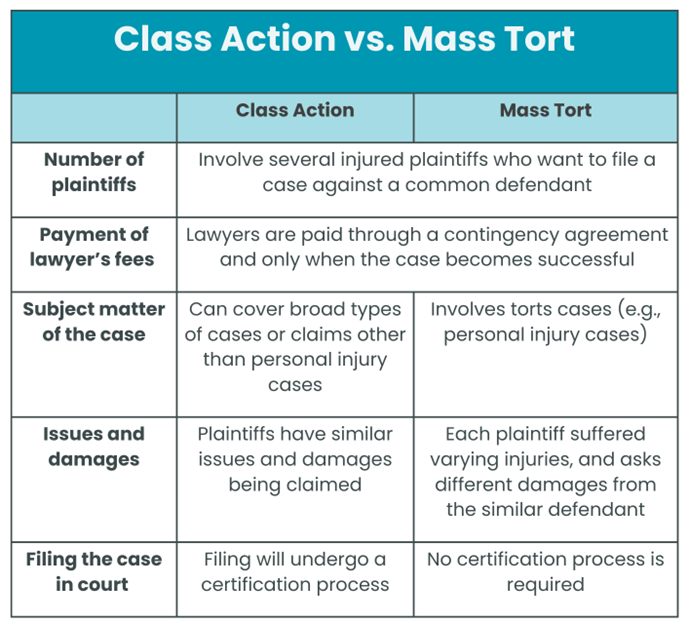When there are several of you who want to file a case in court, you might wonder if that falls under class action or a mass tort. While asking your lawyer is the better thing to do, this article will discuss the similarities and differences between a class action vs. mass tort.
What is a class action?
A class action is a civil case filed against a common defendant by a group of people who suffered similar injuries. While the extent of these injuries don’t have to be exact and identical, it must be caused by the defendant’s acts or omissions, or their negligence.
To know more about how a class action works, watch this short video:
Consult with the best class action lawyers in Canada as ranked by Lexpert for more details about how to start a class action in your province or territory.
What is a mass tort?
A mass tort is a group of individual tort cases pursued against a common defendant. These cases are grouped together because of some commonalities; for example, their injuries may be caused by a single event, or they’re suing a common defendant.
What are the differences between class action vs. mass tort?
Here are some of the differences between class actions and mass torts:
- Subject matter of the case
- Uniformity of issues and damages
- Filing the case in court
Each will be discussed below. You may also want to check the largest class action lawsuits in Canada for groundbreaking case studies on class actions.
1. Subject matter of the case
Class actions and mass torts differ on the subject matter of the case filed in court. Mass torts involve personal injury cases that injured or affected several people. An example of this is a case of product liability injuries. Here, the several plaintiffs (the customers) collectively file a case against the defendant (the corporation or producer of the product) for the injuries they’ve suffered.
Class action cases can cover any type of claim; it may or may not involve personal injury cases. Aside from personal injuries, class actions can also cover the following cases or claims:
- claims against institutions (e.g., the government, financial institutions)
- claims for product misrepresentations and warranties
- environmental protection and restitution cases
- intellectual property cases
- cases on labour, employment, and workplace health and safety
These are just examples of the subject matter that a class action can cover.
2. Uniformity of issues and damages
A class action is different from a mass tort when it comes to the issues to be resolved by the court. When the plaintiffs have similar issues and damages claimed for, a class action is suitable for them. However, when the issues and damages are different for each plaintiff, even though its cause is similar, then a mass tort would be a better choice.
This distinction is important because the amount of court award or settlement will differ between the two actions. In a class action, the amount can be similar for all plaintiffs. In a mass tort, plaintiffs might receive varying amounts because of the different injuries they suffered. In other words, damages are considered on a case-by-case basis in mass torts.
3. Filing the case in court
Class actions start with the filing of a statement of claim. Some provinces and territories have specific names for this, such as an application or a petition. In Québec, this is called application for authorization.
Mass torts begin when each plaintiff files their case in court. When it becomes too many, the court can group this into a mass tort.
Another difference between class actions and mass torts is the need for representation. In a class action, it’s required that a representative plaintiff be named, who must pass certain standards (e.g., must have no conflict of interest, etc.). This is not the case in mass torts, since each plaintiff handles their own case.
What are the similarities between a class action vs. mass tort?
Despite its differences, there are similarities between class actions and mass torts. They both involve:
- Multiple injured persons
- Contingency agreement as payment of lawyers
Let’s discuss these similarities below. Another point of similarity: both class action and mass tort take time to be resolved. Check out our article on how long a class action lawsuit takes to find out more.
1. Multiple injured persons
Class actions and mass torts involve multiple injured persons, which is also a factor why these two actions are always confused. For both actions, a single act, omission, or negligence of the defendant brought plenty of injuries to different individuals. To save time and resources, class actions and mass torts are great ways to pursue a cause of action against a common defendant in an effective manner.
2. Payment of lawyers
Lawyers acting for class actions and mass torts are usually paid through a contingency agreement. In this fee arrangement, they will be paid only after the case becomes successful, such as:
- when the court has awarded damages to the plaintiffs; or
- when a settlement is reached between the plaintiffs and the defendant
Class action vs. mass tort: a summarized comparison
Here’s a summary of the similarities and differences between a class action and a mass tort:

Class action lawyers are experts in deciding what course of action is suitable for your case. As such, it’s important to talk to one so that you’re legally guided before pursuing any course of action.
For more information on comparing class action vs. mass tort, you can reach out to the Lexpert-ranked best class action law firms in Canada.
Related Articles You Might Like:
How to avoid paying taxes on settlement money in class actions





